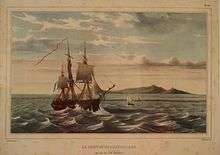French ship Astrolabe (1781)
 French Corvette Astrolabe | |
| History | |
|---|---|
| Namesake: | Astrolabe instrument |
| Builder: | Le Havre |
| Launched: | 1781 |
| Christened: | Autruche |
| Reclassified: | Frigate in 1784 |
| Fate: | wrecked on Vanikoro 1788 |
| General characteristics | |
| Class and type: | Fluyt |
| Displacement: | c. 500 tonnes |
| Length: | 38.7 m (127 ft) |
| Beam: | 8.5 m (28 ft) |
| Draught: | 5 m (16 ft) |
| Propulsion: | Sail |
| Complement: |
|
| Armament: | 12 6-pounders; 3 x 1-pounders and 20 swivel guns (as converted) |
| Armour: | Timber |
The Astrolabe was a converted flûte of the French Navy, famous for her travels with Jean-François de Galaup, comte de Lapérouse.
She was built in 1781 at Le Havre as the flûte Autruche for the French Navy. In May 1785 she and her sistership Boussole (previously the Portefaix) were renamed and rerated as frigates, and fitted for round-the-world scientific exploration. The two ships departed from Brest on 1 August 1785, the Boussole commanded by Lapérouse and the Astrolabe under Paul Antoine Fleuriot de Langle.
Disappearance
The expedition vanished mysteriously in 1788 after leaving Botany Bay on 10 March 1788. The fate of the expedition was eventually solved by Captain Peter Dillon in 1827 when he found remnants of the ships the Astrolable and the Boussole at Vanikoro Island in the Solomon Islands. The ships had been wrecked in a storm.
Survivors from one ship had been massacred while survivors from the other ship had constructed their own small boat and sailed off the island, never to be heard from again. [1]
Legacy
The fate of Lapérouse, his ships and crew was a subject of mystery for some years. Louis XVI reportedly often inquired whether any news had come from the expedition, up to shortly before his execution. It is also notably the subject of a chapter from Twenty Thousand Leagues Under the Sea by Jules Verne.
See also
Note
Its crew included French priest Louis Receveur the first Catholic and second non-indigenous person to be buried in Australia.
References
- ↑ Australian Shipwrecks - vol1 1622-1850, Charles Bateson, AH and AW Reed, Sydney, 1972, ISBN 0-589-07112-2 p24